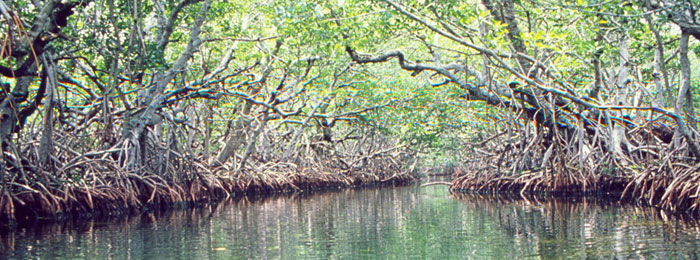What are they?
Mangroves are trees and shrubs that live in salty water. Not many trees can do this, which is readily apparent in some areas of coastal Louisiana, where saltwater intrusion has killed plants that aren’t well-equipped to live in such a hostile environment.
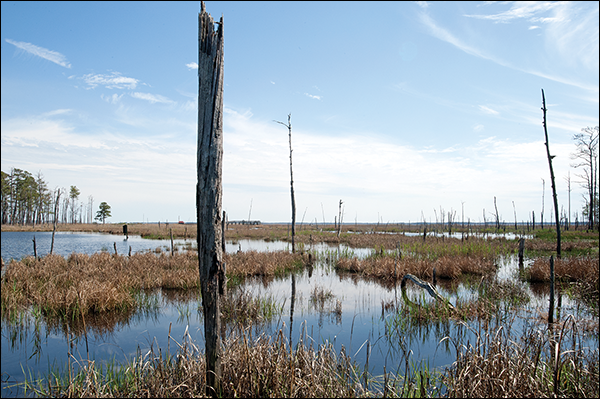
Trees killed by saltwater intrusion. Image: Daniel Strain (Maryland Sea Grant)
When people imagine mangroves, they usually are thinking of red mangroves. These grow along the edge of the shoreline and have prop roots, which grow from the trunk down into the water and are exposed rather than covered in soil the way most plant roots are. Prop roots help provide stability to red mangroves and supply oxygen to underground roots.
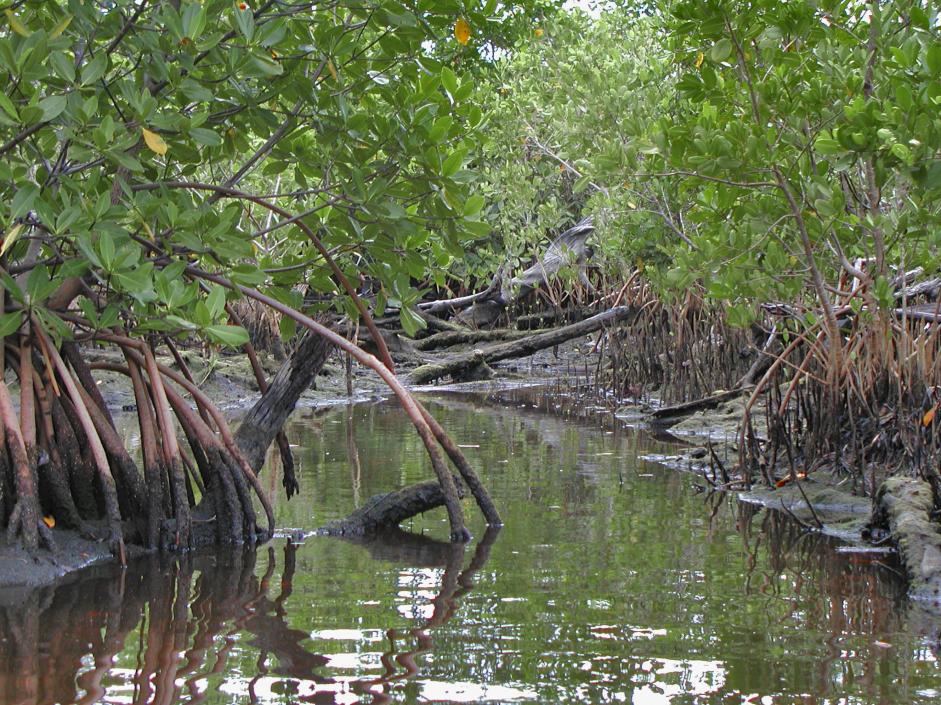
Red Mangroves. Image: NOAA Fisheries
Besides red mangroves, there are 80 other described species, but only three others that are prevalent into Gulf coastal areas. These are black mangroves, white mangroves, and buttonwood.
Black mangroves live in areas higher above sea level than red mangroves. They have horizontal roots with projections called pneumatophores and their roots are exposed to air when tides are out. These mangroves are the type showing up in some of the northern Gulf states.
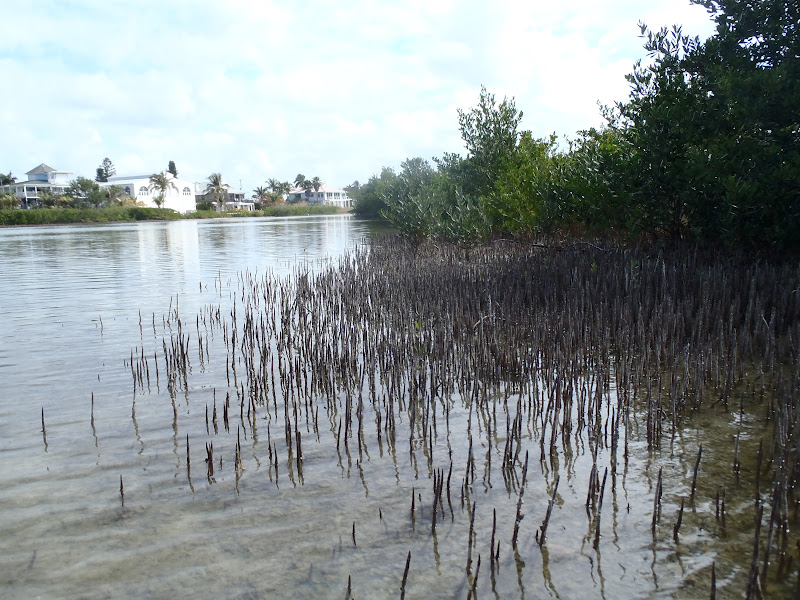
Black Mangroves. Image: Collier County Sea Grant
White mangroves and buttonwood live in more upland areas than either the black or red mangroves. They are adapted to tolerate salty soil, but are rarely exposed to submersion in water, because of this, they do not have aerial roots like the other two species. In general, they look very similar to a shrub you might have in your yard.
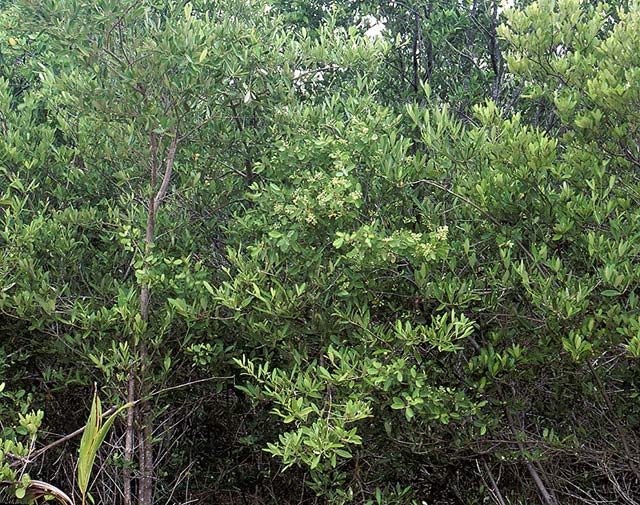
White Mangroves. Image: Miami-Dade Sea Grant
Where are they?
Mangroves live at the transition from sea to land, and are an integral component of estuarine ecosystems, but if you live in Alabama you probably haven’t seen any there. They are usually found in areas that have regular tidal flow, some freshwater, and low to moderate wave energy (think channels in southern Florida and the Florida Keys). Their distribution is limited by freezing temperatures, which is why they are uncommon in the northern Gulf states. However, black mangroves, which are more cold tolerant, can be found on the Chandeleur Islands off Louisiana. They’ve also started popping up on the Mississippi Barrier islands (Scheffel et al. 2013), and scientists suspect that as the global climate continues to warm, black mangroves will continue their spread north in the Gulf of Mexico (Sherrod and McMillan 1985; Pickens and Hester 2010; Cavanaugh et al. 2014).
For now though, mangroves are most prevalent in central and southern Florida and southern Texas.
To see if there are any mangroves near you, check on the interactive map below.
* These data were collected and synthesized by the Commission for Environmental Cooperation. More information regarding how the data was gathered is available in the report, “North America’s Blue Carbon: Assessing Seagrass, Salt Marsh and Mangrove Distribution and Carbon Sinks”. The report is available here
Role of Mangoves in Fishery Ecosystems
The first, and most obvious, role of mangroves in fisheries ecosystems are as nursery areas. Many coral reef associated fish, and some species managed by the Gulf of Mexico Fishery Management Council, start their lives in the mangroves. The prop roots of red mangroves provide protection and feeding habitat for goliath grouper, red grouper, gag, cobia, gray snapper, red drum, and king and Spanish mackerel, to name a few.
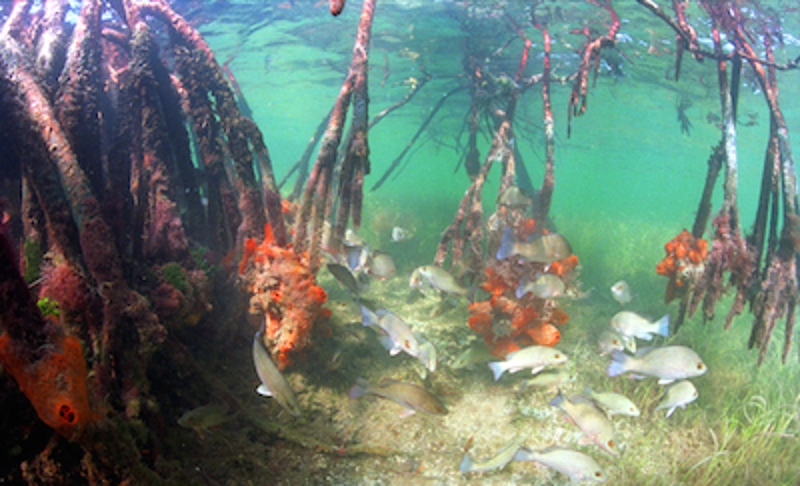
Fish swimming in mangrove roots. Image: NOAA
Another function of mangroves, and most estuarine vegetation, is in carbon sequestration, which is just a fancy way of saying that mangroves remove CO2 from the atmosphere and store it in their tissues and soil surround their roots Hutchinson et al. 2014) . Maybe you can see where this is going, but less CO2 in the atmosphere means less CO2 available to contribute to ocean acidification and, unless you’ve been living under a rock, you’ve probably heard that ocean acidification is a large contributor to coral bleaching (Anthony et al. 2008; Hoegh-Guldberg et al. 2007). Unfortunately, the removal or deforestation of mangroves can release that CO2 right back into the atmosphere.
Another interesting and relatively recent (2014) discovery is that mangrove habitats may provide some coral species refuge in an increasingly hostile ocean environment. In Hurricane Hole, St. John, USVI, researchers surveyed coral communities growing near mangrove habitats, and compared the prevalence of bleaching in corals that were shaded by mangroves to those that were not. Colpophyllia natans and Diploria labyrinthiformis colonies were the most abundant reef building corals in Hurricane Hole and these were doing well despite declines in abundance on St. John reefs. None of the shaded colonies of C. natans were bleached, compared to 10.5% of unshaded colonies, and 34.2% of D. labyrinthiformis shaded colonies were bleached, compared to 66.1% of unshaded colonies (Yates et al. 2014).
Not only do the mangroves provide shade, which reduces coral exposure to photosynthetically active radiation, but also buffer declines in water pH (Yates et al. 2014).
These mangrove habitats may reduce stress and increase survivabily for corals that are threatened by rising water temperatures and increased ocean acidification.
Threats to Mangroves
Most threats to mangroves are human-caused, and because of the locations where they reside, these threats are particularly pronounced. Coastal areas are prime real estate, and as such, are subject to heavy development pressure. Impounding and ditching for mosquito control, reductions in freshwater inflows, clearing, and dredge and fill activities associated with navigation and the aforementioned coastal development are all threats facing mangroves (Duke and Kruczynski 1992; GMFMC 2004).
Pollution, specifically oil, fertilizers, and pesticides/herbicides can negatively impact mangroves. Oil coats their roots which limits oxygen transport, herbicides have been shown to cause defoliation and may be lethal to seedlings (Teas 1976).
References:
Anthony, K. R. N., D. I. Kline, G. Diaz-Pulido, S. Dove, and O. Hoegh-Guldberg. 2008. Ocean acidificiation causes bleaching and productivity loss in coral reef builders. PNAS, 105(45): 17442-17446.
Cavanaugh, K. C., J. R. Kellner, A. J. Forde, D. S. Gruner, J. D. Parker, W. Rodriguez, and I. C. Feller. 2014. Poleward expansion of mangroves is a threshold response to decreased frequency of extreme cold events. Proceedings of the National Academy of Sciences, 111(2):723-727.
Duke, T. and W. L. Kruczynski. 1992. The status and trends of emergent and submerged vegetated habitats of the Gulf of Mexico coastal waters, USA. EPA 800-R-92-003. Stennis Space Center, Mississippi. 161 pp.
GMFMC. 2004. Final Environmental Impact Statement for the Generic Essential Fish Habitat Amendment to the following fishery management plans of the Gulf of Mexico (GOM): Shrimp Fishery of the Gulf of Mexico, Red Drum Fishery of the Gulf of Mexico, Reef Fish Fishery of the Gulf of Mexico, Stone Crab Fishery of the Gulf of Mexico, Coral And Coral Reef Fishery of the Gulf Of Mexico, Spiny Lobster Fishery of the Gulf of Mexico and South Atlantic, and the Coastal Migratory Pelagic Resources of the Gulf of Mexico And South Atlantic. Gulf of Mexico Fishery Management Council, Tampa, Florida, 682 pp.
Hoegh-Guldberg, O., P. J. Mumby, A. J. Hooten, R. S. Steneck, P. Greenfield, E. Gomez, C. D. Harvell, P. F. Sale, A. J. Edwards, K. Caldeira, N. Knowlton, C. M. Eakin, R. Iglesias-Prieto, N. Muthiga, R. H. Bradbury, A. Dubi, and M. E. Hatziolos. 2007. Coral reefs under rapid climate change and ocean acidification. Science, 318: 1737-1742.
Hutchinson, J., A. Manica, R. Swetnam, A. Balmford, and M. Spalding. 2014. Predicting Global Patterns in Mangrove Forest Biomass. Conservation Letters, 7(3): 233-240.
Pickens, C. N., and M. W. Hester. 2011. Temperature tolerance of early life history stages of black mangrove Avicennia germinans: Implications for range expansion. Estuaries and Coasts, 34:824-830.
Scheffel, W. A., K. L. Heck Jr., J. Cebrian, M. Johnson, and D. Byron. 2013. Range expansion of black mangroves (Avicennia germinans) to the Mississippi Barrier Islands. Gulf of Mexico Science, 31(1/2): 79-82.
Sherrod, C. L. and C. McMillan. 1985. The distributional history and ecology of mangrove vegetation along the northern Gulf of Mexico coastal region. Contributions in Marine Science, 28:129-140.
Teas, H. J. 1976. Herbicide toxicity in mangroves. EPA-600/3-76-004. Environmental Research Laboratory, Gulf Breeze, Florida. 42 pp.
Yates, K. K., C. S. Rogers, J. J. Herlan, G. R. Brooks, N. A. Smiley, and R. A. Larson. 2014. Diverse coral communities in mangrove habitats suggest a novel refuge from climate change. Biogeosciences, 11: 4321-4337.
